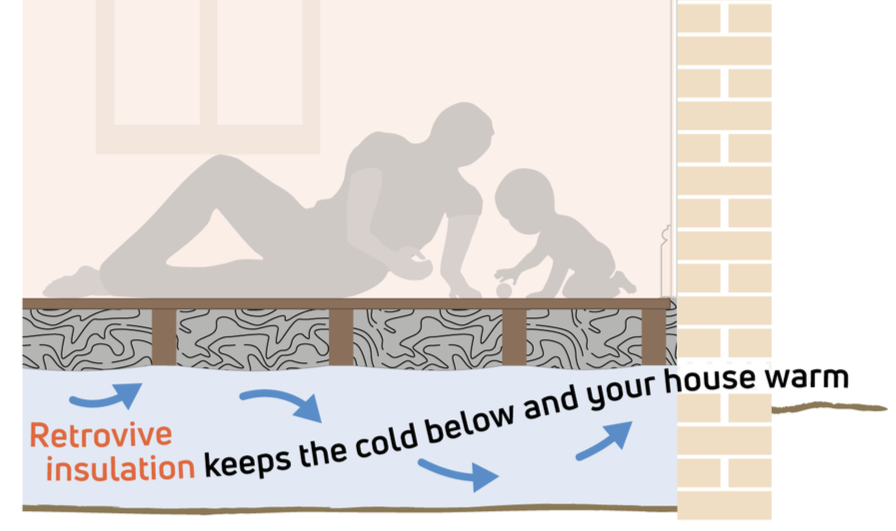The Ultimate Guide to Period Home Underfloor Insulation
- Tom Collings
- Sep 3
- 4 min read

If your period home has suspended timber ground floors, you’re probably losing heat through the ventilated void below and feeling cold from floor-level draughts.
The most effective, least disruptive fix is breathable underfloor insulation that blocks draughts, protects timber, and preserves the ventilation airgap. Rooms can often be insulated in a day, with minimal disruption and no need for redecoration.
Why period homes feel cold, even with the heating on
Victorian and Edwardian houses are beautiful, but often chilly. Suspended timber floors sit above a ventilated void with cold air flowing beneath your feet and finding its way up through gaps between floorboards and skirtings. The result is heat loss plus constant draughts, which add to the feeling of discomfort.
Learn more about the building physics in our explainer: Why are traditional houses in London so cold?

How Retrovive’s breathable underfloor insulation works
A breathable membrane is fixed beneath the joists at the optimal depth.
Cellulose fibre is blown in under pressure to fill corners and stop draught paths.
The original ventilation airgap is maintained below so the subfloor can continue to breathe via airbricks.
Only a few boards are lifted; most rooms are completed in a day.
See the step-by-step process with diagrams: How does Retrovive underfloor insulation work?

Homeowner in London or the South and East of England? Book installation before the first cold snap. Get a quote
Benefits you’ll feel straight away
Warmer rooms at lower thermostat settings (you save twice: less heat lost and fewer draughts).
Draught blocking: dense, gap-free packing eliminates the leaky cold spots that cut-to-fit insulation sheets often leave.
Timber-safe & breathable: moisture is buffered and dissipated through the ventilated void.
Acoustic comfort: cellulose density absorbs sound for quieter footsteps and calmer rooms.
Minimal disruption: few boards lifted and skirtings and floor levels stay put.
Moisture control & breathability
Older floors were designed to breathe. Non-breathable foams or plastic barriers can trap moisture, risking condensation and rot. Retrovive’s vapour-open membrane and cellulose allow moisture to buffer and dry to the ventilated void, protecting joists and boards. Learn how our system maintains breathability for a healthy environment: Breathable membranes & moisture control
Best materials for suspended timber floors
Blown-in cellulose fibre: dense, gap-free, breathability matched to heritage construction; carbon-negative, safe and natural.
Avoid spray foams or rigid PIR sheets that block vapour and are hard to remediate.
Cut "batts" of mineral wool and similar are hard to keep in place and fit neatly, leaving gaps exposed to wind-washing in ventilated voids.
Compare options: What insulation is best for Victorian & Edwardian houses?

Underfloor heating vs underfloor insulation
If you're weighing up underfloor heating against floor insulation, we have provided a handy overview: Underfloor heating or insulation: which is best?
Key Feature | Underfloor Heating (Electric/Water) | Retrovive underfloor insulation |
Floor Height Change | Raises floor by 25-35mm or more | No change to floor height |
Installation Disruption | Significant (lifting floors, adding insulation below) | Minimal (only a few boards lifted) |
Energy Use | High (especially electric systems) | No energy used (lots of energy saved) |
Draught Proofing | No (unless insulation is also installed) | Yes (draught proofing is important for comfort) |
Need for multiple trades | Yes (plumbing or electrical work) | No (Retrovive is often installed in a day) |
Thinking about costs? We give clear, fair quotes with no big up-front payments. See typical costs
What to expect on installation day
Room prep: Please clear furniture and floor coverings (eg lift the carpet) in the work area before we arrive.
Selective lifting: We carefully lift only a few boards per room for access.
Membrane fit: Breathable fabric “hammock” fixed beneath joists.
Blown-in cellulose: Installed under pressure to the specified depth, filling all the gaps.
Clean finish: We replace the boards, reusing the nail holes for a neat finish, tidy the room and check you're happy.
Service walk-through: What to expect from the Retrovive service
General info: Installation & timelines

Care & maintenance
Low maintenance system; just remember to keep external airbricks clear.
Spill-tolerant: Liquids spilt through floorboard gaps can dry to the ventilated void thanks to breathability.
Local service areas
We insulate period homes across London, the South and East of England. Popular areas include: Hampstead, Highgate, Islington, Camden, Muswell Hill, Crouch End, Finchley, Barnet, Enfield, Hackney and Haringey.
Quick FAQs
What floors benefit most?
Suspended timber floors with a ventilated subfloor void (typical in Victorian/Edwardian homes).
Will it trap moisture?
No, our membrane and cellulose are vapour-open and we maintain a ventilation gap below the insulation.
How long does it take?
Often one day per floor with minimal disruption. Larger or more complex projects may be staged over a few days.
Do I still need underfloor heating?
Usually not. Proper insulation stops heat loss and blocks draughts without raising floor levels.
Ready to make your period home cosy?
Tell us about your rooms and we’ll send a clear, fair quote.





